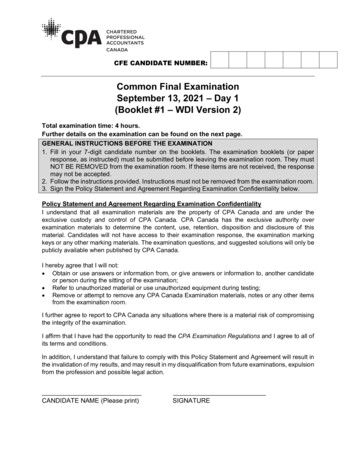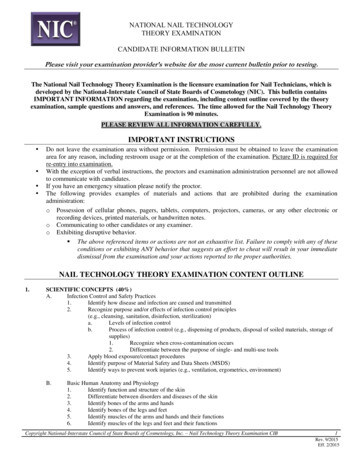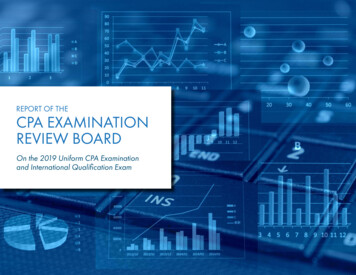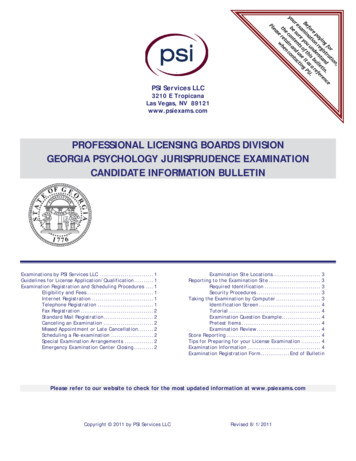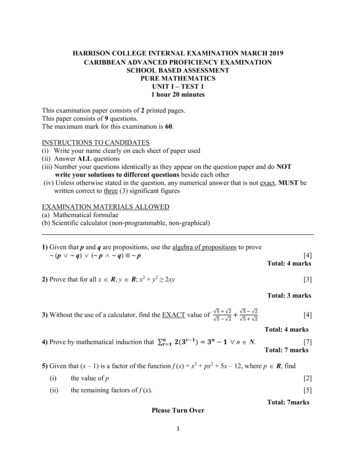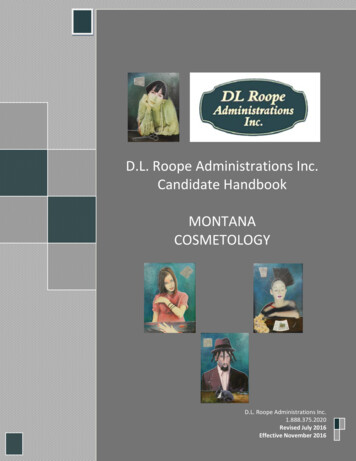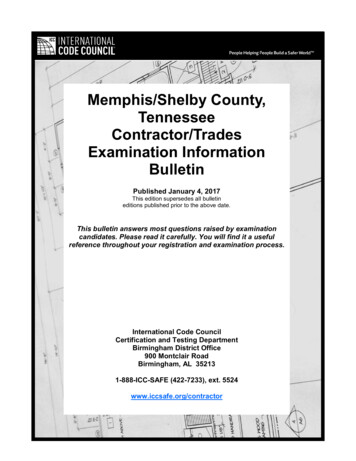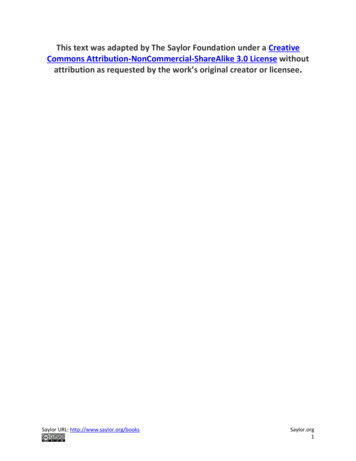
Transcription
An Updated Examination of Social andEmerging Media Use in Public Relations Practice:A Longitudinal Analysis Between 2006 and 2014Donald K. Wright, Ph.D., APR, Fellow PRSAHarold Burson Professor andChair in Pubic RelationsCollege of CommunicationBoston, Massachusetts, USADonaldKWright@aol.comandMichelle Drifka Hinson, M.A.Vice President – MarketingEye Exposure andAdjunct InstructorDepartment of Public RelationsSchool of Journalism and CommunicationsUniversity of FloridaGainesville, Floridamichelle.hinson@rocketmail.comAn earlier version of this article was presented the International PublicRelations Research Conference, Coral Gables, Florida, March 2014.
Public Relations Journal Vol. 8, No. 2ISSN 1942-4604 2014 Public Relations Society of AmericaAn Updated Examination of Social and Emerging Media Use in PublicRelations Practice: A Longitudinal Analysis Between 2006 and 2014Donald K. Wright, Ph.D. and Michelle Drifka Hinson, M.A.ABSTRACTThis article reports on a nine-year longitudinal analysis studying how social and otheremerging media technologies are bringing dramatic changes to how public relations ispracticed. The major finding in the 2014 study involves Twitter narrowly replacingFacebook for the first time as the most frequently accessed new medium for publicrelations activities. LinkedIn and You Tube were the next most frequently used sites. Forthe third year in a row, this research found the influence of traditional mainstream newsmedia continuing to weaken. Results also found considerably more support for thesuggestions that blogs, social and other emerging media are enhancing public relationspractice and that social and other emerging media continue to influence traditionalmainstream media. Findings show those who practice public relations continue to agreestrongly that social and other emerging media are changing the way public relations ispracticed. This impact continues to be much more pronounced for external than internalaudiences. In terms of how social media are impacting communication strategy, 2014results found most (77%) recommend using different messages for various social mediaplatforms, but only 57% of their organizations actually do disseminate different messagesfor different social media platforms.INTRODUCTIONThis is a report on results of a nine-year longitudinal analysis studying how socialand other emerging technologies are impacting public relations practice. Beginning in2005 and continuing every year since, this research has included annually conductedsurveys measuring the impact social and other emerging technologies are having onpublic relations (Wright & Hinson, 2006a, 2006b, 2007a, 2007b, 2008a, 2008b, 2008c,2008d, 2008e, 2009a, 2009b, 2009c, 2009d, 2010a, 2010b, 2010c, 2010d, 2010e, 2011a,2011b, 2011c, 2012a, 2012b, 2013a, 2013b & 2014. Also see DiStaso, McCorkindale &Wright, 2011).1
Public Relations Journal Vol. 8, No. 2ISSN 1942-4604 2014 Public Relations Society of AmericaAs reported previously, these studies show that various new, emerging and socialcommunication media have brought dramatic changes to many aspects of public relationspractice. Results across all nine years of this study suggest that the development ofvarious new and emerging technologies has significantly empowered a wide variety ofstrategic publics by giving them dynamic ways communicate with a variety of internaland external audiences.The study at hand follows several of our earlier research efforts that examinedcorporate communication policy and the internet (Wright, 1998) as well as the overallimpact of the internet on public relations, journalism and the public (Wright, 2001).IMPACT OF NEW COMMUNICATION MEDIA ON PUBLIC RELATIONSEvery other year the Pew Research Center (2005, 2008, 2012 and 2013) studiesthe sources Americans say they use for news. Understandably, this research has foundmost people blend online and traditional sources in their search for information aboutwhat’s going on in the nation and the world. The most recent study of this nature (2013)found 50 percent of Americans consider the internet to be a major source for national andinternational news. Television (69%) remains the most frequently used news source inthe U.S. with newspapers (28%) and radio (23%) falling farther and farther behind eachyear. These 2013 results represent a big change from earlier Pew Studies. In 2001, 45percent said newspapers were their top source for news with just 13 percent saying theinternet.The internet’s rise in importance is even more pronounced among youngerAmericans with 71 percent of those aged 18-29 now citing the internet as a main news2
Public Relations Journal Vol. 8, No. 2ISSN 1942-4604 2014 Public Relations Society of Americasource. Additionally, these Pew studies report more and more people are receiving newsvia social media such as Facebook and this research also reports the number ofAmericans using tablets and mobile devices to receive news continues to rise.Others also track the use of the internet for news. The Gallup organization saystelevision (55%) remains the preferred news source for Americans with the internet insecond place (21%) followed by print media (9%) and radio (6%) (Saad, 2013). TheMedia and Public Opinion Research Group (2013) reports similar findings with 61% ofAmericans receiving national and international news from television, 14 percent from theinternet, 11 percent from newspapers and 10 percent from radio.This Pew Center research found only 10 percent of American adults were usingthe internet in 1995 compared with nearly 80 percent today. Although internet usegenerally correlates with age, education and household income, huge increases in internetuse have been reported in recent years in virtually all of these demographic categories.For example, nearly half of all Americans over the age of 65 currently use the internetand many of these users are extremely active including 86 percent of them with e-mailand 34 percent with social networks. The Pew studies continue to find youngerAmericans use the new technologies more than their older audiences and younger usersalso are considerably more likely to use the internet for things such as downloadingmusic and movies, etc.As our previous annual reports about this research have indicated, our studiesabout how new technologies and emerging media are impacting public relations practicecome at a significant time for traditional news media, especially newspapers. Paidcirculation figures for daily newspapers in many large American cities continue to3
Public Relations Journal Vol. 8, No. 2ISSN 1942-4604 2014 Public Relations Society of Americadecline resulting in the death in recent years of major city dailies such at Denver’s RockyMountain News, the Baltimore Examiner, the Cincinnati Post, the Albuquerque Tribune,the Oakland Tribune, the San Juan Star and the Honolulu Advertiser. Perhaps the bestinformation source for tracking the changing landscape of the American newspaperindustry is the Newspaper Death Watch (2012, 2013 & 2014) website(www.newspaperdeathwatch.com) that recently reported another emerging trend withU.S. daily newspapers continuing to publish print editions but only two or three dayseach week. In most cases the newspapers publish online versions on the other days.At first this latest trend only became operational with newspapers in mid-sizedcommunities such as Ann Arbor and Flint, Michigan; Madison, Wisconsin; Birmingham,Alabama; Syracuse, New York, etc., but the trend is now prevalent in major cities. Themajor city dailies that have moved in this direction include the Seattle Post-Intelligencer,Detroit News/Free Press, Portland Oregonian, Cleveland Plain Dealer and the NewOrleans Times-Picayune. In spite of a century-long tradition of excellence, the ChristianScience Monitor stopped publishing as a daily in March 2009 in order to concentrate onpublishing a weekly print edition and refining its online offerings. According to BostonMagazine (2009) the Monitor’s circulation had slipped 75 percent between 1969 and2009.Experts who monitor these changes, including those at the USC Center for theDigital Future (2011), predict these trends will continue. Some of these predictionssuggest there might be fewer than a dozen daily print version newspapers in the U.S. bythe end of the current decade.4
Public Relations Journal Vol. 8, No. 2ISSN 1942-4604 2014 Public Relations Society of AmericaThese changes also are taking place with some of the trade magazines that servethe public relations industry. In 2009, PR Week, considered by many to be the nation’smost dominant public relations trade publication, changed its weekly print edition into anonline format, although it does produce a printed magazine each month. Some otherpublic relations trade publications appear to have been impacted recently, including PRNews which now offers nearly as many public relations short courses and seminars as itdoes publications and Bulldog Reporter that has created a series of training courses itoffers under the name of “PR University.”New media have “changed the rules of the game in every part” of strategiccommunication according to Argenti and Barnes (2009). They also claim that over thepast decade these new communication vehicles have not only turned upside downeverything people knew about communication but also have dramatically changed thebusiness of managing relationships. Findings of the noted Authentic Enterprise Report ofthe Arthur W. Page Society (2007) give the new communication media credit fordramatically changing the ways in which stakeholders are empowered. The PageSociety’s most recent report – Building Belief: A New Model for Activating CorporateCharacter and Authentic Advocacy (2012) – examines how the roles and functions ofchief communications officers of major companies are changing given advances in newtechnologies among other things.Social media are being utilized on an ever-increasing basis by corporations andother organizations according to McCorkindale (2010) who reports more than two-thirds(69%) of the current Fortune 2000 companies are using social networking sites. Laskin(2010 & 2012) has addressed the effective use of social media in investor relations.5
Public Relations Journal Vol. 8, No. 2ISSN 1942-4604 2014 Public Relations Society of AmericaBortree and Seltzer (2009) have reported on how advocacy groups are advancing theirpublic relations agendas via Facebook. Bowen (2010) has studied the importance ofethics and stakeholder management in connection with top corporate websites. DiStaso(2012) has researched the importance for organizations to make certain Wikipediacorrectly portrays information about them.Other recent studies include Liu’s (2010) research about differences between howelite newspapers and A-list blogs cover crises; Coombs’ (2012) work detailing thephenomenal potential new and emerging media provide for crisis communicationpractitioners; Gainey’s (2012) research about new media use during crises in the publicsector; and a study by Ruh and Magallon (2009) about the U.S. military using socialmedia for some of its internal communication campaigns. Paine (2009a, 2009b, 2009c)was one of the first to point out many organizations now are trying to measure theeffectiveness of their social media communication efforts.As we have pointed out previously, another measure of the growth anddevelopment of social media in public relations is the level of social media activitycurrently displayed by various professional societies active in the field. In addition to webpages and e-mail communication, social media sites such as Facebook, LinkedIn andothers all have pages organized by organizations such as the Institute for Public Relations(IPR), the International Public Relations Association (IPRA), the Public RelationsSociety of America (PRSA), the Council of Public Relations Firms, the Arthur W. PageSociety and the International Association of Business Communicators (IABC).According to Kelly (2009) and Eberwein (2010), the micro-blogging site Twitterfrequently is the first source to provide news seekers with information about major news6
Public Relations Journal Vol. 8, No. 2ISSN 1942-4604 2014 Public Relations Society of Americaevents including the 2008 terrorist attacks in Mumbai, India; the massive 2010earthquake in Haiti; and the US Airways flight landing in the Hudson River on January15, 2009. This trend has continued during the past two years with disaster events such asthe assassination attempt of U.S. Representative Gabrielle Giffords on January 8, 2011;the massive earthquake that devastated Japan on March 11, 2011; the series of tornadoesthat swept through six states in the American south in April 2011; the January 2012capsizing of the Italian cruise ship Costa Concordia off the Tuscan coast on January 13,2012; and the plane crash in a crowded neighborhood of Lagos, Nigeria, that killed morethan 150 people on June 3, 2012. While he was Editor of PR Week, Keith O’Brien(2009), pointed out “there has been great progress in the use of social media to reachvarious constituencies.”PURPOSE OF THE STUDYAlthough others have examined the huge impact new communication media arehaving on the practice of public relations, there are fewer studies looking at how publicrelations practitioners actually are using these new media. The nine-year tracking of newand emerging media use in public relations practice reported about in this articleprovides one of the most extensive examinations of how social media are beingimplemented in public relations practice. In addition to measuring how social media arebeing employed in the practice of public relations, this study also explores actual newcommunication media use by individual public relations practitioners.This study’s longitudinal analysis of a larger-than-usual number of researchsubjects also has the potential of enhancing the credibility of scholarly research in publicrelations. As Dougall (2006) explains, the lack of a significant number of panel and trend7
Public Relations Journal Vol. 8, No. 2ISSN 1942-4604 2014 Public Relations Society of Americastudies in the public relations literature does not reflect positively on our field when thepublic relations body of knowledge is compared with research productivity in thetraditional social sciences and other professions.Also, since more than half of the survey research projects in the public relationsliterature contain reports about studies involving less than 350 respondents, and morethan two-thirds of these studies have usable responses from fewer than 250 subjects, thelarger-than-usual number of participants in the study at hand – 3,009 respondents duringthe past six years – is a plus for public relations research.METHODA trend analysis was employed with a fairly extensive web-based questionnaire.In light of many changes in the new or emerging technologies since we started thisresearch in 2005, a good number of our questions have changed over the years. However,we have been asking many of the same questions annually since 2009, some every yearsince 2008 and a few each year since 2005. Some modifications were made in the 2014questionnaire that included 69 questions. Most (61) of these were closed-ended questionsof substance. There were three open-ended questions and four demographic measures.The majority of the longitudinal analysis reported on in this article is based uponresponses to the study’s web-based questionnaire by six different large, purposivesamples of public relations practitioners who took part in this survey research study in2009, 2010, 2011, 2012, 2013 and 2014. Invitations to participate by completing thestudy’s web-based questionnaire were extended in 2009 and 2010 via e-mail messages topurposive samples collected from membership rosters of the Public Relations Society ofAmerica (PRSA), the Arthur W. Page Society and the International Public Relations8
Public Relations Journal Vol. 8, No. 2ISSN 1942-4604 2014 Public Relations Society of AmericaAssociation (IPRA). Additional subjects were gathered from donor, task force andcommission membership lists of the Institute for Public Relations (IPR). During the threeyears prior to 2009 we conducted annual surveys of public relations practitionersmeasuring their use of new technologies. However, since most of the questions we askedin 2006 required significant revision before being asked again in 2009 and beyond, theresearch team decided to limit the longitudinal data analysis to the last four years. Inthose cases where data exists, results covering more than four years are reported.Subjects in 2011, 2012, 2013 and 2014 were selected via a random sample ofPRSA members who received e-mailed invitations to participate. The first e-mailinvitation in 2014 was distributed on February 2 and a reminder invitation was circulatedon March 2. There were 378 usable responses in 2014 yielded from approximately 4,250e-mailed invitations representing a return rate of about nine percent. When response ratesfrom PRSA members started declining in 2013, it became necessary to reach out togroups of practitioners who might not necessarily have been part of the random sample.These groups have included those named above as well as practitioners who havecompleted questionnaires for this study during previous years.The longitudinal analysis reported on in this article is based upon a grand total of3,009 respondents (n 574 in 2009, n 563 in 2010, n 479 in 2011, n 622 in 2012,n 378 in 2013 and n 393 in 2014) an average of 502 respondents each year.DEMOGRAPHICSMost (more than 90 percent) of this study’s subjects are from North America,other respondents have come from many different parts of the world representing a goodcross-section of the public relations industry.9
Public Relations Journal Vol. 8, No. 2ISSN 1942-4604 2014 Public Relations Society of AmericaOf the 3,009 respondents over the six years data were gathered for this study, 25%were employed with public relations agencies (5% with large firms and 20% with smallor mid-sized agencies), 19% worked in corporate public relations, 16% held non-teachingpositions in education, 15% came from non-profit public relations, nine percent workedin government settings, five percent came from health care communications, two percentwere research services providers and nine percent answered “other” or did not respond tothe demographic questions.The 2014 respondents included 23% who worked with public relations firms(18% with small or mid-sized agencies and five percent with large firms), 16% holdingpositions in corporate public relations, 15% in governmental public relations, 15% fromthe non-profit sector and another 15% holding non-teaching positions in education. Fivepercent of this year’s respondents worked in health care communications, one percentwere employed by research provider companies and 10% answered “other” or did notrespond to this demographic question.Responses were nicely distributed across various age categories in all of the years.The overall average of respondents for all six years was 38.2 and the six-year genderbreakdown was 68% female and 32% male. The study had more male respondents inearlier years as 48% of the 2009 respondents were male compared with 24% in 2014.RESULTSAs Table 1 indicates, results of our 2014 study show public relations practitionerscontinue to agree strongly that social and other emerging media are changing the waypublic relations is practiced. Although mean scores on this item dipped slightly in 2013,the 2014 results represent the highest mean scores in the nine years we have been asking10
Public Relations Journal Vol. 8, No. 2ISSN 1942-4604 2014 Public Relations Society of Americathis question. This was true for how new technologies have impacted the wayorganizations communicate, how they have communicate to external audiences and howthey communicate to internal audiences. This impact continues to be much morepronounced for external than internal audiences.Mean scores in 2014 also were higher than previous years when subjects were askedif blogs, social and other emerging media have enhanced public relations practice. Scoresalso were higher to the question asking if social and emerging media influence traditionalmainstream media. Mean scores in 2014 on these two items were the highest they’ve everbeen since we first started asking this question in 2008.For the first time since we began asking the question in 2010, Twitter replacedFacebook as the most frequently accessed new medium for public relations activities.This is the first time Twitter has been on top of this list in the five years we have beenasking this question. Another major finding, for the third year in a row, mean scorescontinued to get significantly lower on the item asking if traditional mainstream mediainfluence social and other emerging media.As more in-depth analysis shown in Tables 9 and 10 explains, this year’s resultinvolving Twitter and Facebook is very close. Twitter’s mean score was 4.12 andFacebook’s was 4.07. This question focused on how frequently subjects access specificnew media sites as part of their work in public relations. Respondents were specificallyasked not to count personal use on these sites. Facebook access was the lowest we’verecorded in the five years we’ve been asking this question. Twitter access was the highestit has been during that time. As explained in the tables, these mean scores are based uponresponses to five-point Likert-type scales where “1” represented “very infrequently” and11
Public Relations Journal Vol. 8, No. 2ISSN 1942-4604 2014 Public Relations Society of America“5” equaled “very frequently.” Consequently, the higher the mean score the greater thefrequency of use.For the third year in a row, mean scores were significantly lower on the item asking iftraditional mainstream media influence social and other emerging media. The 2014results on this question represent the lowest mean scores recorded in the seven years wehave been asking it. These results strongly reflect national opinions bout the decreasinginfluence of traditional news media (newspapers, magazines, radio and television).Results in 2014 suggest the percentage of time public relations practitioners spendwith blogs, social and other emerging media during their workdays is leveling off.Findings on this item are fairly similar to results from 2012 and 2013. This year 3% toldus more than 75% of their time is spent working in social and emerging media; 8% saidthey spend between 51% and 75%; 21% spend between 26% and 50%; 39% answeredbetween 11% and 25%; 28% responded between 1% and 10% and 1% told us they do notspend any time working in those areas.Two of the study’s items during the past six years have been concerned with whichorganizational function is responsible for monitoring and managing social and emergingmedia communication in organizations. Results are displayed in Tables 4 and 5. Theyshow that although a clear majority (64% in 2014) believe this should be theresponsibility of communications and public relations, the emergence of digital and/orsocial media departments certainly has lowered that percentage from where it was in themid-to-lower 80s it between 2010 and 2012.12
Public Relations Journal Vol. 8, No. 2ISSN 1942-4604 2014 Public Relations Society of AmericaAdditionally, while 77% of the 2014 respondents told us this should be acommunications and public relations responsibility, that percentage is lower than themid-90s numbers recorded on this item in 2010, 2011 and 2012.Every year since 2009 we have asked subjects to rank the importance of a variety ofemerging media in the public relations efforts of their organizations. They also wereasked to tell us how important they thought these media should be.As Table 7 indicates, 2014 results found the following ranked highest on the “howimportant SHOULD THEY BE list”: 1st social networks (such as Facebook andLinkedIn), 2nd video content sharing sites (YouTube, Flickr, Instagram, etc.), 3rd microblogging sites (Twitter), 4th search engine marketing, and 5th blogs. Four of these (socialnetworks, video sharing sites, micro-blogging sites and blogs) received higher meanscores in 2014 than in any of the previous five years. Mean scores for search enginemarketing on this item were a little bit lower in 2014 than in 2013.As indicated in Table 6, these same items were ranked as the top-five on the listasking, “How important ARE these media in the public relations efforts of yourorganizations.” However, the order was slightly different with micro-blogs ranked secondand video content sharing sites ranked third. Social networks remained first while searchengine marketing and blogs were ranked fourth and fifth respectfully.Statistical analyses of mean analyses for all of these items between 2009 and 2014can be found in Table 8. This table shows the smallest gap between what practitionersthink should be happening and what really is happening in terms of new media use inpublic relations belongs to social networks (Facebook, LinkedIn, Google , etc.). Micro-13
Public Relations Journal Vol. 8, No. 2ISSN 1942-4604 2014 Public Relations Society of Americablogging sites such as Twitter and social media management sites such as Hootsuite aretied for second. Search engine marketing is fourth while blogs are fifth.In a continuing attempt to gauge the integrity of this year’s respondents, as we havedone for the past three years, we listed two non-existing media – “prSpace” and “PRnet”– as answer options to the new media usage question. Fortunately, nearly all respondentstold us they’ve never used “prSpace” or “PRnet.” However, we are a little bit concernedabout the two percent who told us they “frequently” use PRnet.In addition to frequency of use results involving Twitter and Facebook mentionedpreviously, Tables 9 and 10 display additional information about the changing use inpublic relations practice of other social networking, micro-blogging and video sharingsites. The use of LinkedIn for public relations purposes continues to increase and it isnow a distant third to Twitter and Facebook with YouTube very close behind in fourthplace. As Table 10 shows, Google continues to struggle in these measures.Subjects also were asked several questions about public relations strategy and socialmedia communication. Results indicate while most (76%) recommend using differentmessages for various social media platforms, only 57% of their organizations actually dodisseminate different messages for different social media platforms.SUMMARY AND CONCLUSIONSOur ninth annual survey measuring how social and other emerging media are beingused in public relations practice found practitioners continue to agree strongly that thesenew media are changing the way public relations is practiced. This impact continues to bemuch more pronounced for external than internal audiences. Although mean scores on14
Public Relations Journal Vol. 8, No. 2ISSN 1942-4604 2014 Public Relations Society of Americathis item dipped slightly a year ago, results in 2014 contain the highest mean scores in thenine years we have been asking this question.The major finding in this 2014 study involves Twitter narrowly replacing Facebookfor the first time as the most frequently accessed new medium for public relationsactivities. LinkedIn and You Tube were the next most frequently used sites. This resultinvolving Twitter and Facebook is very close. Twitter’s mean score was 4.12 andFacebook’s was 4.07. This question focused on how frequently subjects access specificnew media sites as part of their work in public relations. Respondents were specificallyasked not to count personal use on these sites.For the third year in a row, this research found the influence of traditional mainstreamnews media continuing to weaken. Results also found considerably more support for thesuggestions that blogs, social and other emerging media are enhancing public relationspractice and that social and other emerging media continue to influence traditionalmainstream media. The 2014 results found most (77%) recommend using differentmessages for various social media platforms, but only 57% of their organizations actuallydo disseminate different messages for different social media platforms. Results in 2014also suggest the percentage of time public relations practitioners spend with blogs, socialand other emerging media during their workdays is leveling off.For the third year in a row, mean scores were significantly lower on the item asking iftraditional mainstream media influence social and other emerging media. The 2014results on this question represent the lowest mean scores recorded in the seven years wehave been asking it. Two of the study’s items during the past six years have beenconcerned with which organizational function is responsible for monitoring and15
Public Relations Journal Vol. 8, No. 2ISSN 1942-4604 2014 Public Relations Society of Americamanaging social and emerging media communication in organizations. Results show thatalthough a clear majority believe this should be the responsibility of communications andpublic relations, the emergence of digital and/or social media departments certainly haslowered that percentage from where it was in the mid-to-lower 80s it between 2010 and2012.16
Public Relations Journal Vol. 8, No. 2ISSN 1942-4604 2014 Public Relations Society of AmericaMEAN COMPARISON TABLESThese tables compare mean scores of various questions asked each year.Table 1Mean analyses of responses to the question: “Please tell us whether you agree ordisagree that the emergence of social and other emerging media has changed the wayyour organization (or your client organizations)”:Communicates?Handles externalcommunication?Handles internalcommunication?2006n 4822007n 4762008n 4962009n 5
decline resulting in the death in recent years of major city dailies such at Denver's Rocky Mountain News, the Baltimore Examiner, the Cincinnati Post, the Albuquerque Tribune, the Oakland Tribune, the San Juan Star and the Honolulu Advertiser. Perhaps the best information source for tracking the changing landscape of the American newspaper
